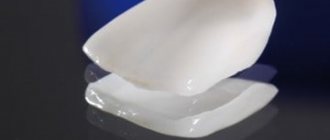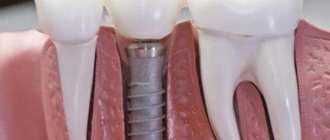What are the benefits of dental filling?
Filling is a simple and at the same time effective way to solve the problem of caries of the front teeth. Using this procedure allows a person to fully use their teeth even at a very advanced age. It is worth saying that a filling on the front tooth is not always necessary; if the disease is weakly affected, you can do without this procedure, but if the caries has already penetrated deeply and created a threat of tooth loss, then there is no way to do without a filling.
Note: We must not forget that advanced caries can lead to much more serious diseases, in particular infection of the rest of the human body.
Installation of veneers
If a piece of your front tooth breaks off, what should you do?
Veneers are small shells on teeth made from ceramic, composite material or zirconia. They can be used to repair chips or cracks, correct shape or minimize gaps. In appearance and structure, they can completely replicate natural enamel. Now let’s consider the next option for solving such a problem as a chipped front tooth, and let’s talk about ultra-veneers.
When a small piece of a front tooth breaks off, it is important to find out in advance what to do.
Types of caries on the front teeth, classes
Caries is a disease that affects dental tissues, but the degree of their destruction may vary, depending on this, the following stages of the disease are distinguished:
- Initial or spot stage. As a result of the leaching of vital and necessary substances from the enamel, some darkening of the teeth is observed. A person is not able to notice such an unpleasant and significant symptom; only a specialist can successfully do this.
- Superficial. Only tooth enamel is affected by caries, but the changes occurring in it are irreversible, its structure does not have the ability to recover independently. It is at this stage of destruction that a reaction to cold and hot, as well as to sweet and sour, appears.
- Average. The appearance of pain in the teeth, and quite sharp ones, the stains grow more and more, and if they are not there, then the symptom is the appearance of cracks, which again are noticeable only to the doctor.
- Deep. Black spots on the enamel, the disease affects the dental nerves.
Caries affecting the front teeth is usually divided into five classes:
- Damage to the contact part of the tooth, a sign may be a small triangular-shaped clearing on the enamel.
- Fissure caries affecting the lateral teeth responsible for the chewing process.
- Damage to contact enamel most often occurs in those who cannot imagine their life without sweets in large quantities.
- Destruction of the cutting edge angle.
- The appearance of root caries.
Installation of lumineers
So, half of the front tooth has chipped off, what to do in this situation? Lumineers are a new word in the field of microprosthetics. They are a very thin ceramic plate placed on the teeth to mask an enamel defect. They are also used to get a radiant smile if the color of your own enamel, even as a result of whitening, remains somewhat yellow or gray. It must be said that most people's natural enamel is not white, but with a special undertone. Installation of lumineers does not require turning of the cutter. They are made of durable ceramic and can easily last twenty years, or even more, when a piece of a front tooth breaks off.
What else should I do?
Features of the front row restoration
Fillings for the front teeth are selected and installed based on the natural color of the enamel. When restoring incisors, differences in shades and the degree of transparency of different areas of the tooth must be taken into account:
- the surface of the edge is characterized by thin dentin, connected to a rather dense layer of enamel, due to which this area is much more transparent;
- closer to the gum, the enamel thickens, and the dentin mass, on the contrary, contracts;
- The neck is distinguished by a thin layer of enamel, which connects to a large volume of dentin, in this place the enamel is darker and less transparent.
It is these factors that pose particular difficulties in the process of restoration of the frontal row . Therefore, the price of fillings for the front teeth is much higher than for the rest.
Making a filling
For fillings with direct restoration, a viscous composite is used, which is subsequently processed with a special lamp. As for the indirect method, a hard tab is used here. It can be made of ceramic or composite material.
Modern technologies make it possible to secure this element accurately and conscientiously. Such inlays are produced in specialized laboratories or performed using a CEREC device. It allows you to reproduce a three-dimensional matrix of the desired design according to a photograph, and then grind it.
This method makes it possible to find the most suitable inlay for the front incisors and save on the production time of the filling.
Cleansing enamel: why is this procedure necessary?
To ensure that the restored tooth has an aesthetic appearance, a filling is placed after first selecting the desired tone. This is done in a special room with white walls and bright lamps.
It is possible to obtain a more reliable result through the enamel cleansing procedure . This is done using a directed flow of a special drug. It removes various layers from the surface of the enamel, including tartar, due to which the tooth acquires natural whiteness. In addition to cleansing the enamel, the procedure allows for the prevention of a number of dental diseases.
Seal installation technology
People have been afraid of the dental chair since childhood. Today, a lot has changed, and any clinic will provide a choice of analgesics, with the help of which the treatment procedure will be painless. In addition, modern dentistry is able to offer a filling for the front tooth, which will have a natural appearance and will be invisible to others.
The filling itself consists of several stages. The time spent on treatment will depend on the difficulty of the restoration work. As a rule, the duration of the procedure ranges from 30–60 minutes.
The main stages of installing a seal:
- Diagnosis of the problem and selection of treatment.
- Choosing an anesthetic drug.
- Elimination of areas affected by caries.
- Removal of inflamed pulp and treatment of wounds in the presence of pulpitis. If pathogenic flora remains under the filling, this can lead to the development of new inflammation.
- Installation of a seal. The filling material is applied to the diseased tooth in layers; to harden, each layer is illuminated with a photopolymerization lamp. If the filling is ordinary, the prepared mass is simply placed into the dental cavity using a special tool.
- Grinding and polishing of the cutter.
- X-ray of the treated tooth to confirm the quality of the work performed.
Filling the front tooth, nuances
When restoring the front teeth, the dentist is faced with the task of not only restoring damage, but also preserving beauty, so filling material is of great importance. It should be:
- biocompatible;
- immune to temperature changes;
- resistant to chewing load;
- indistinguishable from natural enamel;
- durable.
This is interesting: What is “plasmolifting” and for what purpose is the procedure carried out in dentistry?
In their work, doctors use silicophosphate cement, acrylic-containing plastic, compomers, but do not deny that the best results are provided by photopolymer and light fillings. Their composition instantly hardens under the influence of ultraviolet radiation and imitates the shade of enamel.
After cosmetic repairs, the tooth looks healthy and beautiful. Preparing a carious cavity and installing a filling occurs in a standard way.
When filling front teeth, attention is paid to aesthetics
What anesthesia is used
We figured out whether fillings are placed on incisors, we looked at possible options, but we still need to highlight one important nuance. In its classic version, the procedure does not involve contact of the instrument with the pulp, so sometimes it can be performed without anesthesia at all. Of course, anesthesia is usually performed before treatment to eliminate any discomfort for the patient. For this purpose, standard local anesthesia is used.
Generally, local anesthesia is used for treatment
How long does installation take?
The procedure does not last very long, but much will depend on the scale of the lesion and the amount of restoration work. Typically, 30-60 minutes are enough to install one filling. More time may be required if nerve removal and root canal treatment are to be performed.
How is the installation carried out?
The initial work and treatment of the damaged tooth itself is no different from all other types of therapeutic dental treatment. The canals are cleaned in the same way, and if necessary, then expanded.
Next, we will describe the procedure itself step by step.
- First of all, it is necessary to select the most natural color of the material for each case, using a special scale.
- If necessary, anesthesia can be administered. This may be necessary when working on sensitive areas.
- Treatment of the affected area of enamel with a dental drill (drill).
- Isolating a problematic tooth from saliva using cotton balls and a saliva ejector.
- Treatment of the affected area with a special liquid - an adhesive, which usually comes with the fillings themselves. This liquid is also photosensitive and must be treated with a lamp.
- Now the filling material itself is applied in layers. Modeling of the desired configuration occurs after application, right in the oral cavity.
- Now the doctor spends some time treating the installed filling using an ultraviolet ray.
- After these procedures, the final step is to grind and polish the surface. Sometimes it is also coated with a special varnish.
In fact, the biggest difference is that light fillings, unlike chemical fillings, are subject to ultraviolet treatment.
In the following video you will learn about the procedure for restoring anterior teeth using light fillings:
Which fillings are preferable for front teeth?
Each filling has its own advantages and disadvantages; to understand this, you should familiarize yourself with each of the options.
Silicate fillings
This material is often chosen for the restoration of anterior teeth.
Silicate or silicophosphate materials are a common choice for the restoration of the anterior zone. However, this option has some disadvantages:
- yellowish tint, which often stands out against the background of the natural color of the enamel,
- installation is quite complex - for the seal to stand firmly and for a long time, a specialist must have the appropriate experience and skill,
- cannot be polished
- may cause a sour taste in the mouth.
The composition does not contain toxic substances, and therefore is absolutely safe for the body. This is one of the reasons why silicates are widely used in pediatric dentistry. True, they are not very reliable and can fall out.
Plastic solutions
The material is also used for the restoration of incisors, but has several significant disadvantages. Firstly, the installation process takes longer. Secondly, plastic is difficult to process and settles heavily after hardening. Thirdly, it can quickly darken and fall out over time. Such fillings are not characterized by long-term use and sufficient aesthetics.
Dental restoration with light fillings
Composite restoration services are very common today.
It is a polymer filling with nano-sprays. This method of restoration is quite affordable and allows you to get rid of most tooth enamel defects in 1-2 hours. Photopolymers are often compared to veneers. This is not correct, since polymer veneer can replace ceramics only in rare cases, because it is impossible to correct severe crooked teeth with its help.
A composite plate lasts about five years. Patients diagnosed with it must limit their food intake and stop smoking. Products that have staining properties can ruin the color of your teeth.
Despite this, many doctors recommend dental restoration with a light composition. Since this method is less traumatic, and photopolymers are much easier to repair. If a chip occurs on the ceramic, it is necessary to remove the plate, and the composite is easily restored.
It is advisable to carry out restoration with light compounds in the following cases:
- The damage amounts to no more than a third of the tooth.
- The patient carefully observes hygiene.
- Restoration is a temporary measure.
- The patient expects an affordable option.
A patient who has had photopolymer used for dental restoration needs to visit a doctor once or twice a year for additional surface grinding.
Key differences between light filling and chemical filling
In the modern world, installing lighting composition is becoming increasingly popular.
What are the main differences between light and conventional fillings?
Chemical can be used in the treatment of one molar, with a small cavity.
If a filling needs to be installed on the front teeth, a light filling is the only right choice. It will blend one hundred percent with the tone of the patient’s teeth, and the beauty of the smile will not suffer at all.
Note: In addition, installation of a light composition is less painful; during its implementation, the patient does not hear the frightening sounds of a drill and does not feel severe discomfort, as when installing a composition made of chemical materials.
Advantages and disadvantages
The main advantage of the material for light fillings is its high plasticity.
When used, the material does not harden ahead of time, and the doctor can easily fill the tooth cavity, preserving all its anatomical features. A huge number of shades of light fillings and the ability to choose them without harming the beauty of your smile is an equally important plus.
Also, this type of filling is perfectly polished, as it is completely non-toxic, which gives it superiority over chemical ones.
The disadvantages include the inability to use light compositions in hard-to-reach places where it is more appropriate to use a chemical composition.
If the patient needs a temporary filling, it is also better to use another type, since the properties of a light filling are not suitable for this procedure, and it is also expensive.
Indications
The main indication for installing a light filling is the absence of a coronal part of no more than 1/3 of its volume . It is used both for surface defects and chips, and for deep lesions of the crown.
Also, light polymer is used for severe tooth pigmentation , which cannot be eliminated by other methods.
Why does a light filling stick well to teeth?
The light composition holds up well due to two factors.
First of all, this is the use of a colorless liquid - adhesive. With its help, the tooth cavity is washed, illuminated with a lamp, and filling begins.
Also, thanks to the treatment of the tooth with a special lamp, the communication processes between the tooth body and the filling with the help of calcium are enhanced. The bonds in the tooth tissues are strengthened, and the filling holds better.
This is interesting: Resorption of bone tissue of the roots of teeth: types, causes, symptoms and treatment
What rules and prohibitions must be observed if you have installed a light seal?
What should patients who have a light filling not eat?
These are, of course, products that can lead to staining: black tea, coffee, Coca-Cola, beets, pomegranate juice. These foods should be excluded from the diet for 3 days after the filling procedure to avoid staining.
Life time
Depending on many factors, a light filling may last a different amount of time for different people. On average, dentists estimate the lifespan of light-cured composite fillings to be three to five years. But depending on various reasons, the filling may last less or longer than this period.
The duration of service depends primarily on how correctly the patient cares for his oral health and follows the specialist’s recommendations. What the patient eats also plays an important role. Products of plant origin can strengthen teeth, but sweets and flour products, on the contrary, shorten the life of the crown.
Advantages and disadvantages
Compared to other materials for fillings, light seals have certain advantages:
- Pronounced plasticity , which allows the dentist to form a filling in detail without fear of its premature hardening.
Thanks to this, the material completely fills all cavities and microdefects of the treated crown surface. The same property allows the material to be applied in layers, due to which the filling has an increased density and better adhesion to the crown. - Hypoallergenic. Studies have shown that the components included in this material do not cause allergies. This means that this type of filling can be used to restore the anterior crowns of any patients.
- Accurate color reproduction . To obtain the required shade, the dentist uses several colors at once from a wide range of colors, which are usually provided by suppliers. When the shades are mixed, they give a color that completely matches the natural crown.
- Possibility of delayed adjustment . Even when the material has completely hardened, it is easy to grind and polish.
- Ease of use . There is no need for pre-mixing to apply the light composite. The product is supplied in special syringes with a small dispenser, with which the dentist measures the required volume.
- Fast setting. To wait for the restored area to harden, you need to wait less than a minute.
The disadvantages of restoration using a light filling include the following:
- The use of a UV lamp is mandatory, which affects the cost of the service.
- Lack of stable stability in case of extensive crown defects, since the filling is subject to shrinkage.
- Over time, the material may become subject to pigmentation and surface abrasion .
- After a long period, the border line becomes noticeable , which often becomes the cause of secondary caries.
Find out why a tooth hurts after root canal filling and what to do in such a situation.
This article describes the symptoms of a wisdom tooth: fever, pain, etc.
And here https://zubovv.ru/lechenie/zubyi/lz-mudrosti/rastet-v-shheku-pochemu-i-chto-delat.html advice on what doctors recommend if a wisdom tooth grows into the cheek.
Basic requirements for materials
The requirements for materials were formulated quite a long time ago, back in the twentieth century, but so far there have been no fundamental changes in them. In order for a material to be used for filling, it must have the following characteristics:
- resistance to chemical and mechanical stress;
- ability to withstand chewing loads and pressure (up to 60 kilograms);
- meet aesthetic requirements, in particular in matters of color and texture;
- have a high adaptive capacity;
- quickly and efficiently adhere to the tooth surface;
- maintain basic performance qualities during the period of use of the product;
- provide reliable protection to the sensitive pulp and nerve endings from the effects of hot and cold substances;
- have biological compatibility and resistance to inflammatory processes.
Modern technologies have made significant progress in this matter, but we have to admit the fact that there is no ideal material yet, this is a matter for the future.
Possible complications after restoration
The feeling of pain after installing a filling is quite natural and is associated with the cleaning of the canals. As a rule, the pain lasts for some time, then it subsides. However, if the work was done poorly, the discomfort will persist for a long time. In this case, the seal will need to be reinstalled.
The procedure for filling the front teeth may be accompanied by other failures, for example, the patient could flinch during the preparation, and the dentist accidentally burned the pulp. In addition, sometimes the following troubles occur: damage to the enamel surface, the development of allergic reactions to the medications used.
What to do if the filling on the front tooth has darkened?
The appearance of darkening can be caused by the action of food dyes, but you should still see a doctor immediately so that he can make sure that there is no caries or any inflammation. If everything is fine, the specialist may recommend taking more careful care of your oral cavity and removing some foods from your diet.
Whitening
For many patients, the question of the possibility of whitening fillings on the front teeth is relevant, but here it should be clearly understood that if we are talking about a crown, then whitening becomes impossible, as for the filling, the filling itself will not directly change color, but the enamel will become lighter.
For large fillings, the whitening procedure is also impossible, otherwise the teeth will become stained. If we are talking about small products, then this procedure is quite acceptable, but in this case the fillings will have to be replaced with new ones so that their color does not differ from the teeth that have become lighter. This solution will still be temporary, since soon the enamel will darken again and then the whole procedure will have to be repeated from the very beginning. If the patient nevertheless makes such a decision, then he needs to remember that whitening of sealed teeth is carried out in three stages:
- Professional teeth cleaning.
- The whitening procedure itself.
- Replacing old fillings with new ones.
Cleaning teeth
The location of the recovery procedure and the chosen method play a huge role in achieving the desired result. The cabinet must be equipped accordingly; in addition, the enamel must be cleaned to its natural color; in this case, the Air flow technique is best suited, the use of which allows you to achieve a whitening effect without chemical exposure.
Filling care
There will be no serious restrictions, but you should still adhere to the recommendations below so that the product lasts a long time and does not cause any concern:
- do not eat anything solid for one to two days after treatment;
- at least for the first time after the procedure, use a soft brush and special medicinal pastes to brush your teeth;
- refrain from eating too hot or too cold food;
- give up for a while sticky products that can pull out the filling, plus they can provoke the appearance of new cavities affected by caries;
- in order to prevent the possibility of deformation of the product, it is better to initially reduce the chewing load on the treated side;
- If any discomfort or inconvenience occurs, you should immediately see a doctor.
Recommendations
Since whitening is not possible for large fillings, an alternative is to use ceramic veneers that will not change their color. In general, it is not worth doing whitening without serious reasons; you should not unnecessarily expose your teeth to the risk of chemical exposure. In fact, it makes sense to perform whitening only if there are clinical indications; in other situations, it is better to refrain from this procedure.
Selection by color
When part of a front tooth breaks off, many people wonder what to do. One of the dentist’s tasks is to choose the color of future structures. As part of the restoration or prosthetic process of one or more front incisors, the shade is selected based on the patient’s own color. While making veneers or crowns, it is possible to select the desired color. In this case, you should take into account the shade of the whites of the eyes, hair and skin. You also need to focus on the material from which the orthopedic structure will subsequently be made. Ceramic metal differs significantly from composite material and plastic, but has the same color index.
Under different lighting, the shade of teeth can be perceived differently. Therefore, when choosing the color of veneers or crowns, it is necessary to do this in natural light, in a place with a neutral color near the walls, and women should not have lipstick on their lips. Professional specialists will help you choose the ideal shade so that your smile can look as natural and attractive as possible if a piece of your front tooth breaks off. Not everyone knows what to do.
Service life and replacement
The service life of such a filling is usually 7-10 years
Now about how long the photopolymer lasts on the incisor. Its service life usually varies from 7 to 10 years. Over time, hard tissue will continue to deteriorate, which will lead to depressurization of the composite, and this is a direct path to relapse of the disease. To prevent this, you need to replace it in a timely manner. It is only important to take into account that with each such replacement, the walls of the tooth gradually become thinner, and the service life of each subsequent filling will be shorter.
That is why, when after several replacements the material no longer holds, the doctor suggests installing a pin or stump with an artificial crown. This measure will provide the patient with full functioning of the incisor for another 8-10 years.
Why can the service life of a filling be reduced?
Sometimes dental products of this type fall out, crumble, and caries develops underneath them. There are a number of reasons for this:
- Incomplete cleaning of the tooth from carious tissue. The disease is simply closed, and it continues to progress. The tooth gradually deteriorates, the product ceases to perform its functions, and may simply fall out of the cavity.
- Incorrect formation of the cavity for installation of the product.
- Lack of protection from moisture during cavity closure. Some substances are not resistant to moisture. Due to the action of saliva, they cannot harden and consolidate normally. To prevent this, the working tooth is limited from the oral cavity with a rubber dam - a latex scarf.
- Insufficient light penetration when curing the filling with a lamp. The light wavelength for curing the composite must be at least 450 nm. For curing, special battery-powered lamps are used. If there is not enough charge, light will not penetrate well into the layers of the workpiece. The inside of the structure will remain loose. Such a product will quickly fall out of the tooth or gradually shrink, which will then lead to the development of secondary caries.
This is interesting: Features of open and closed sinus lift
These are factors related to the doctor's qualifications. But a lot depends on the patient. If the doctor tells you not to eat food or chew gum for two hours, then you need to strictly follow his instructions.
How to care for your mouth after filling
As for why light fillings on front teeth may fall out, there are many potential reasons for this. The problem may be poor quality treatment, unsatisfactory care from the patient and the development of secondary caries. To prevent such a situation through your own fault, you should listen to the recommendations of experts regarding care after treatment and restoration:
- be careful with solid foods for a couple of days after treatment,
- at first, it is advisable to use a brush with soft bristles and fluoride-containing paste, if there are no contraindications to it,
- avoid sudden temperature changes in food and drinks,
- carry out self-cleaning twice a day, rinse your mouth after every meal,
- reduce the load on the restored element for several days,
- in the future, systematically visit the dentist for preventive maintenance and prof. hygiene.
By following the rules of hygiene, you can extend the life of your fillings.
If you experience obvious discomfort or even pain, you should contact your dentist as soon as possible. Timely treatment will protect against complications and help save most of the hard tissues from destruction.
Installation
Installing a light filling on the front crowns differs little from standard filling in the treatment of caries or pulpitis.
The procedure begins with an examination of the oral cavity and local anesthesia. The whole process takes place in several standard steps:
- The dentist prepares a carious cavity . If the caries has penetrated deeply, then the pulp chamber is opened and canals are formed.
- The tooth canals are cleaned and filled with gutta-percha , and only then do they begin to restore the crown.
- Before placing a filling, the doctor determines the shade of the material . To do this, use a special scale, which first correlates with the color of the crown, and then with the filling agent.
- The cavity to be restored is ground down using a dental bur.
- To prevent saliva from entering the treated area, a rubber dam and a saliva ejector are installed. The crown is covered with cotton swabs.
- The area to be restored is dried and covered with a product based on orthophosphoric acid for 40 seconds. It allows you to slightly loosen the surface, increasing the pores of the dental tissue. This will increase the area of adhesion of the material to the tooth.
- The acid is washed off with water and the surface is dried again.
- An adhesive substance is applied to the prepared cavity , which enhances the adhesion of the dental tissue to the composite.
- Next, the composite is applied . Each layer is treated for 1–2 minutes with an ultraviolet lamp.
- The hardened filling is formed and refined by grinding .
- At the end of the procedure, the surface of the tooth being treated is coated with fluoride varnish . It helps strengthen the enamel and protects the line between the filling and the crown.
This procedure lasts on average about an hour.
Prices
It is impossible to answer the question unequivocally: “How much does a light filling cost for a front tooth?” The final amount that the patient will have to pay lies in a fairly wide range - from 300 to 5000 rubles. You need to figure out what factors the price will depend on, and whether it can be reduced somehow.
- Required volume of material
. The amount of mass for restoration depends on how large and serious the damage is in the diseased tooth. - The tooth itself
. Working with the front teeth is more difficult and therefore more expensive. - Manufacturer
. The latest generation products, the quality of which is backed by research, are more expensive. - Region
. The price also directly depends on where exactly the treatment is performed. The cost of the same servant differs greatly in Moscow and other cities. - Clinic
. Dental clinics have very different statuses. The larger the clinic, the longer it has been on the market, the more serious specialists work there. Accordingly, services there will be more expensive.
Based on this, we can conclude that the patient can only influence the last three factors. On the other hand, it is usually the status of the clinic that changes the price quite significantly.
Free medicine
Installing a free design will significantly save money, but the quality of the filling may suffer as a result.
In general, going to a clinic for free medical care is fraught with disadvantages:
- Modern free dentistry is more designed for people with limited financial resources
Firstly, municipal clinics save on costs , so during work they use the necessary minimum of equipment and tools, and there are no additional amenities. Such treatment will be a priori less comfortable.
- Secondly, filling components supplied by the state are usually cheaper than analogues used in private medicine, so they are less durable and more likely to cause recurrent caries.
- Thirdly, in a municipal clinic the salary is always lower than in a private one, so most dentists in free medicine are either young specialists working for experience, or older doctors of pre-retirement or retirement age.
Important! Specialists will carry out a full range of filling work, and the delivered structure will hold. However, it will look worse, have less strength and will fall out much earlier than the expensive material installed using modern equipment.









